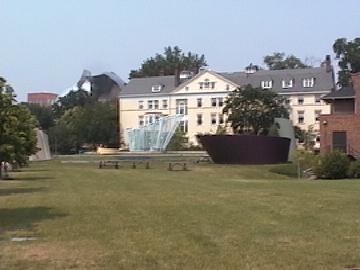30 June, 2002
Research Experience
At the TEA orientation last summer, they kept assuring us, the new TEA's,
that our experience would be unique. That is very correct, and I haven't
even left the country yet.
I am in the second week of my summer research experience and I still have
four to go. Most TEA's spend 10 days to two weeks with their PI's (Principal
Investigators) the summer before their Antarctic experience, but I am
spending six weeks with the ANSMET (Antarctic Search for Meteorites) team at
Case Western Reserve University in Cleveland, OH. Dr. Ralph Harvey, my PI,
felt that it would be difficult to have an authentic research experience in
the span of just a couple of weeks. Already, I can see his reasoning.
Research is not something that can be squeezed into a time frame. It is
something that moves at its own pace, and is subject to its own whims. I
have witnessed several days where Dr. Harvey has several projects planned,
that wind up placed on the back burner while he fixes someone else's
computer, or gives his interpretation of an image derived from a microscope
slide.
Dr. Harvey has trusted me to complete several projects, none of which are
beyond my abilities. In fact, at first, I didn't think he gave me enough to
do. But with each day come new challenges with instrumentation and time
constraints such that, I can see why he didn't overload me with duties. In
fact, he's encouraged me to explore my curiosity. He wants me to visit the
local museums and travel outside the campus. He has been very generous in
loaning me his bicycle and truck to make my transition easier.
Dr. Harvey works most closely with two women. One earned her doctorate
recently and along with her own research is assisting Dr. Harvey with
coordinating the ANSMET team. Two teams will be going to "the ice" this
year, and they need her expertise to supervise the field parties. The other
is finishing up her doctoral work and is trying to decipher the complex
petrology of a very famous meteorite, ALH84001. This meteorite made
headlines worldwide when a team of researchers announced that it contained
fossils of ancient Martian bacteria, along with other chemical traces of
life. As is often the case in science, the pendulum of evidence has swung
the other way, and seems to indicate that those findings were premature and
incorrect. However, it remains one of the most complex meteorites ever
discovered.
Dr. Harvey has reinforced my belief that the best scientists are skeptics.
He is not one to jump on a scientific bandwagon, such as the one that
followed the ALH84001 controversy. Instead, he looks for the answers that
the geology of a meteorite, or terrestrial rock yields. With this philosophy,
the next few weeks should continue to be interesting.

A.W. Smith Building, home of ANSMET

Outdoor art is abundant on the CWRU campus.
Contact the TEA in the field at
.
If you cannot connect through your browser, copy the
TEA's e-mail address in the "To:" line of
your favorite e-mail package.
|
